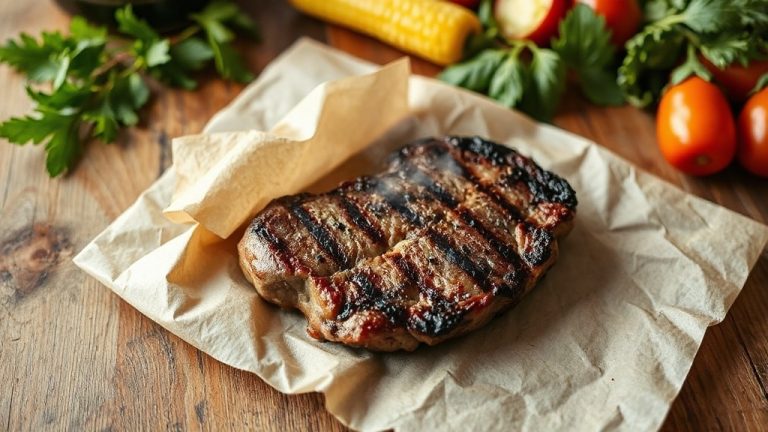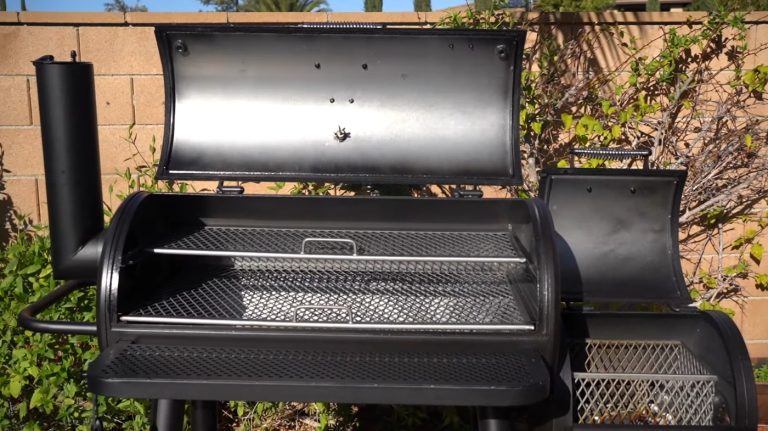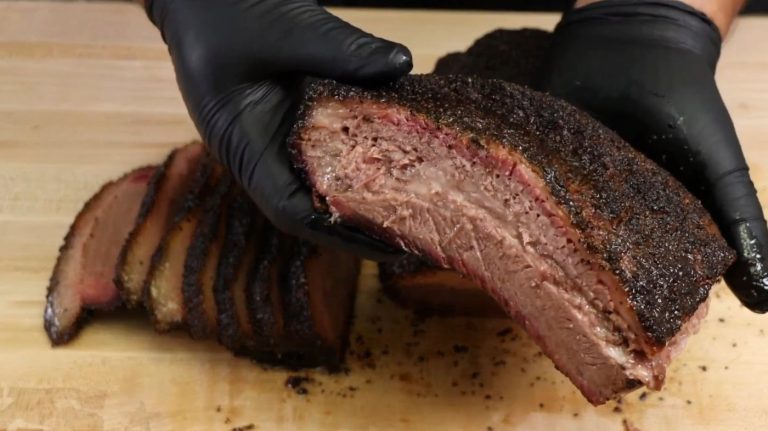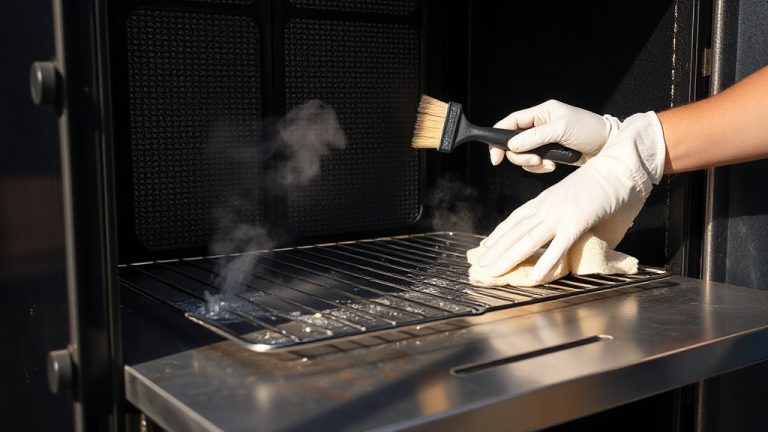How to Smoke Eggplant in a Smoker? Simple Steps to Try
To smoke eggplant, start with firm, evenly sized ones, slicing or cubing after washing. Salt and dry them to reduce bitterness, then marinate if you like.
Preheat your smoker to 225–350°F, using mild fruitwoods like apple for gentle smoke. Smoke slices about 45-60 minutes, flipping halfway, or whole eggplants for 2.5–3 hours at lower temps until tender.
Keep the temperature steady for best texture and flavor development. Learn how to perfect marinades, wood choices, and storage for delicious smoked eggplant.
Key Takeaways
- Select firm, uniform eggplants, slice evenly, and optionally salt or marinate for enhanced flavor before smoking.
- Preheat smoker to 225–350°F, using mild fruitwoods like apple, and arrange eggplant with indirect heat for even smoking.
- Smoke whole eggplants at 225–250°F for 2.5–3 hours or sliced/cubed at 300–350°F for 45–60 minutes, flipping halfway.
- Monitor internal temperature (~190°F) and texture, avoiding over-smoking to prevent bitterness and ensure tender, smoky flesh.
- Store smoked eggplant airtight in the refrigerator for 5–6 days or freeze portions for longer preservation with slight texture changes.
Choosing and Preparing Your Eggplant for Smoking
When selecting eggplants for smoking, you’ll want to focus on varieties that offer tender flesh and a flavorful profile after cooking, such as Japanese, Black Beauty, or Rosa Bianca.
Choose firm eggplants with smooth, unblemished skin and avoid any with soft spots. Smaller or slender types like Japanese or mini-eggplants have fewer seeds and thinner skin, making them ideal for smoke absorption and tenderness.
Asian eggplants, including Japanese types, are known for their thin skin and fewer seeds, which enhances their suitability for smoking. Proper temperature management during smoking is crucial to maintain the eggplant’s texture and flavor.
Heirloom varieties like Black Beauty provide a meaty texture and slightly bitter richness, while Rosa Bianca offers a mild, sweet flavor that holds up well when stuffed or topped.
Guarantee uniform size for even cooking. Wash thoroughly, then slice evenly—rounds or lengthwise—to promote consistent smoke penetration.
Salting can reduce moisture and bitterness; just rinse and dry before smoking. Storing your charcoal in airtight, dry containers helps ensure a clean, consistent smoke flavor throughout the cooking process.
Setting Up Your Smoker for Perfect Eggplant
To achieve perfectly smoked eggplant, you’ll need to carefully prepare your smoker by controlling temperature and selecting the right heat source.
Set your smoker between 225°F and 350°F; higher temperatures speed up cooking but require vigilance to avoid burning.
Use indirect heat to ensure even smoke penetration without charring the surface prematurely. Avoid using softwoods like pine, as their resinous smoke can impart harsh flavors and produce toxic emissions.
Choose mild fruitwoods like apple for a light, sweet smoke that complements eggplant’s delicate flavor. Preheat the smoker fully to stabilize temperature before placing your eggplant.
Arrange slices or cubes evenly on oiled racks or in cast iron skillets, avoiding overcrowding to promote proper smoke circulation.
For whole eggplants, lay them directly on grill grates. Smoking eggplant at a low temperature like 200°F helps maintain a tender texture and enhances flavor when done properly with apple smoke. Use tools like tongs and heat-resistant gloves for safe handling during the process.
Different Smoking Techniques for Eggplant
Although smoking eggplant offers a range of flavor possibilities, selecting the right smoking technique is essential for achieving your desired texture and taste. You can choose cold smoking, which imparts smoke without cooking at under 90°F, ideal if you plan to cook the eggplant later.
Choosing the right smoking method is key to perfect eggplant flavor and texture.
Hot smoking, between 225°F and 350°F, cooks and flavors simultaneously, softening the flesh in 45 minutes to 1.5 hours.
When it comes to form, whole eggplants retain moisture and intensify flavor but need longer times, perfect for dips like baba ganoush.
Sliced or cubed pieces smoke faster and absorb more smoke, ideal for side dishes. Also, consider your equipment: electric smokers offer stable temps for consistent results, while charcoal grills excel with whole eggplant for deep smoky profiles.
For best results, maintain consistent temperature control during smoking to optimize flavor absorption and texture.
Optimal Smoking Temperatures and Timing
Since temperature and timing directly influence both the texture and flavor of smoked eggplant, mastering these variables is key to achieving your culinary goals.
For tender, spreadable eggplant, smoke whole fruit at 225–250 °F for 2.5 to 3 hours until fully collapsed.
If you want sliceable pieces, aim for 300–350 °F and 45 minutes to 1 hour, flipping halfway for even cooking.
Avoid temperatures near 400 °F; they cook faster but risk uneven heat and less smoke absorption. Always preheat your smoker to the target temperature before adding eggplant for consistency.
Monitor softness rather than just time. Longer low-temp smoking yields creamy textures; medium temps balance tenderness and structure.
Over-smoking can cause bitterness, so manage smoke levels carefully throughout the cook for optimal results. Smoking the eggplant enhances its deep, rich taste by adding a subtle smoky flavor that creates a distinctive profile, making it ideal for dishes like baba ganoush traditional preparation methods.
Enhancing Flavor With Marinades and Wood Choices
When you want to elevate the natural earthiness of smoked eggplant, carefully chosen marinades and wood types play an essential role in shaping its flavor profile.
Start by marinating your eggplant in a blend of garlic, basil, balsamic vinegar, olive oil, salt, and pepper for 30 to 60 minutes to deepen its taste. Incorporate fresh herbs and lemon juice for a citrus-herb marinade that adds complexity.
Use olive or avocado oil to enrich texture and promote even seasoning. It is important to keep the marinade in the bowl after grilling so the eggplant can soak up extra flavor before serving, enhancing the overall taste and moisture content marinade soaking. Proper temperature control during smoking ensures the eggplant absorbs smoke flavor without becoming bitter.
Pair mild fruit woods like apple with these herbal marinades to complement without overpowering. Avoid resinous woods, which can introduce bitterness. For bolder flavors, try oak with garlic-heavy marinades.
Monitoring Texture and Doneness of Smoked Eggplant
To achieve perfectly smoked eggplant, you need to closely monitor its texture and doneness throughout the process. Watch for even charring on the skin, slight deflation, and flesh color shifting from bright purple to creamy beige.
Test firmness by gently pressing or piercing with a fork—it should feel tender but not mushy. Use a thermometer to confirm an internal temperature near 190°F (88°C).
Because moisture can affect cooking times, it is important to monitor temperatures continuously to avoid under- or overcooking.
After smoking, let the eggplant rest 10-15 minutes to set the creamy texture. Additionally, ensure the flesh is not slimy, as a slimy texture is a clear sign of spoilage and should be avoided.
Serving Suggestions and Storage Tips for Smoked Eggplant
Although smoked eggplant shines on its own, serving it thoughtfully can elevate its complex smoky flavor and creamy texture. Try it as a dip with fresh vegetables, pita bread, or crackers, or use it as a spread on sandwiches and wraps for added richness.
This versatility makes it ideal for gatherings, picnics, or healthy snacks, providing convenience and flavor. For a deeper smoky profile, pair it with sauces that contain smoked paprika and molasses, enhancing the richness.
Incorporate it into pasta dishes or serve as a side alongside grilled meats or Mediterranean fare. Enhance flavors with fresh herbs like basil or cilantro, spices such as smoked paprika, and acidity from lemon juice or balsamic vinegar.
Garnish with sumac onions or hard-boiled eggs for texture and visual appeal. Store smoked eggplant in airtight containers, refrigerating up to 5-6 days to preserve freshness and meld flavors.
Frequently Asked Questions
Can I Smoke Eggplant Without a Smoker Using Alternative Methods?
Yes, you can smoke eggplant without a smoker by using alternatives like a gas stove burner or gas grill. Hold the eggplant over medium-low flame to char and soften it, or grill it at high heat, turning frequently for even cooking.
You can also roast it in a hot oven with smoky seasonings or use a covered grill with smoking chips to trap smoke. These methods deliver smoky flavor without specialized equipment.
How Do I Prevent Eggplant From Becoming Too Bitter When Smoking?
You might worry smoking eggplant will leave it bitter, but pre-salting slices for an hour draws out that harshness through osmosis. Choose fresh, medium-sized Italian or Japanese varieties with smooth skin to avoid bitterness.
Lightly oil your eggplant, smoke at moderate heat, and avoid charring. After smoking, scoop out the tender flesh, discarding tough skin parts.
What Are the Best Side Dishes to Pair With Smoked Eggplant?
You’ll want to pair smoked eggplant with sides that balance its smoky richness. Try Mediterranean mezze like baba ganoush, roasted peppers, and fresh pita for a creamy, fresh combo. Herbaceous salads with parsley and dill add brightness.
Grilled veggies like zucchini and bell peppers complement the smokiness. Don’t forget grains like couscous with herbs or a tangy feta cheese to add texture and depth to your meal.
Can Smoked Eggplant Be Reheated Without Losing Flavor and Texture?
You can reheat smoked eggplant without sacrificing flavor and texture by using gentle methods. Opt for oven reheating at moderate temperatures, wrapped in foil to trap moisture.
Avoid microwaving unless you use a vented cover to prevent sogginess. Low and slow reheating in a skillet with a bit of oil also works well. Always rest the eggplant for a few minutes after reheating to let flavors redistribute and texture firm up.
Is It Safe to Smoke Eggplant if I Have Dietary Restrictions Like Low Sodium?
Smoking eggplant with low sodium restrictions is as safe as a calm lake on a windless day—you control the ingredients. Since smoking itself doesn’t add sodium, you just need to avoid salty marinades or seasonings. Use herbs, lemon juice, and olive oil instead.
Keep an eye on your total sodium intake and skip commercial mixes. This way, you enjoy smoky flavor without compromising your dietary needs.
Eggplant Elevated: A Taste Worth the Wait
As you pull the smoked eggplant from the heat, imagine a twilight sky—its skin charred like fading dusk, while the flesh softens like whispered secrets beneath. Smoking transforms this humble vegetable into a smoky canvas, each bite painting bold, layered flavors on your palate.
With careful preparation and patience, you reveal a world where texture and aroma dance. Embrace this ritual, and let your smoked eggplant tell a story of warmth, depth, and smoky elegance.






